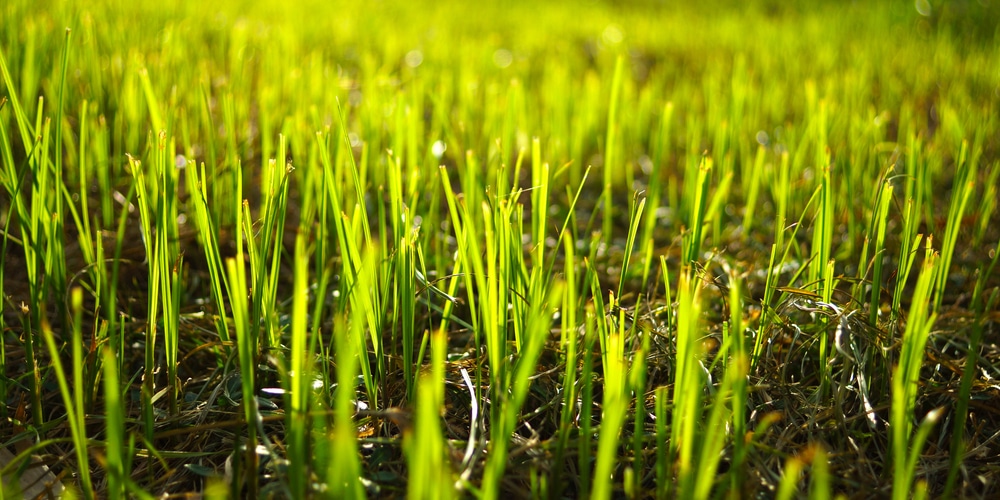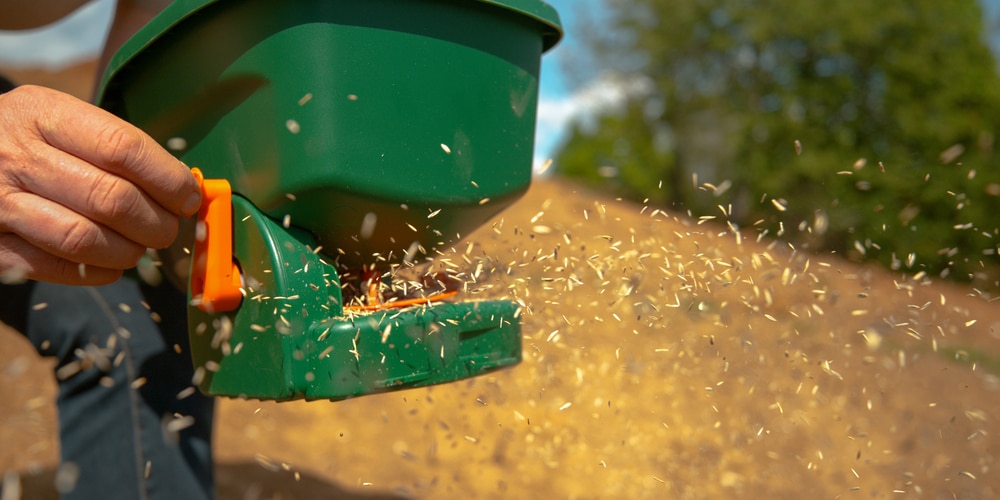How to Tell if the Seeds are Still Good
When it comes to maintaining a lush lawn or a thriving garden, the viability of your grass seed is a crucial factor.
Seed viability refers to a seed’s ability to germinate and grow into a healthy plant.
Understanding how long your seeds will last and the conditions that impact their potency will help ensure that your seeding efforts are not in vain.
Factors Affecting Seed Longevity
Several factors can influence how long your grass seeds remain capable of germinating:
- Storage Conditions: Ensuring that seeds are stored in a cool, dry place can markedly extend their lifespan. High humidity and temperature can accelerate seed deterioration.
- Seed Age: Over time, all seeds will gradually lose viability. The rate of this decline depends on the species and storage conditions.
- Packaging: Seeds sealed in airtight containers are less exposed to environmental factors that degrade seed quality.
Performing regular checks on your seeds can help you gauge their current condition and take action to preserve their viability.
You can conduct a simple germination test to assess if your seeds are still effective.
Signs of Seed Expiration
To avoid the disappointment of a patchy lawn, keep an eye out for these signs that your grass seeds may have expired:
- Poor Germination Rate: If very few seeds sprout during a germination test, it’s a clear indication of reduced viability.
- Mold or Fungus: Visible signs of mold or fungal growth on the seeds suggest that they have been compromised and are unlikely to germinate.
- Unpleasant Odor: Any off-smelling seeds should be considered suspect and likely no longer viable.
Keeping your seeds in a proper environment can significantly delay their expiration, while understanding these signs of seed expiration helps you avoid the wastage of sowing ineffective seeds.
Optimal Storage Conditions
To maximize the lifespan of your grass seed and ensure strong germination, paying attention to temperature, moisture, and light is crucial when selecting a storage location.
Temperature Control
- Keep it Cool: Aim to store your grass seed in a location where the temperature is consistently cool.
- An environment where the cumulative sum of the temperature in degrees Fahrenheit and the relative humidity percentage is close to 100 is ideal.
- For example, at a temperature of 70°F, aim for 30% humidity.
- The 100 Rule for Seed Storage provides a guideline for balancing temperature and humidity.
Moisture Management
- Dry is Key: Storing seeds in a dry place is essential in preventing mold and decay.
- Use sealed containers or bags to protect seeds from ambient moisture.
- Factors Affecting Seed Storage offer insight on how improper moisture levels can impair seed viability.
Light Exposure and Containers
- Shun the Sun: Exposure to direct sunlight can increase temperature and promote humidity, which are detrimental to seed quality.
- Choosing the Right Container: Opaque containers are preferred, as they block light and can also provide an additional barrier against moisture.
- Tips on Seed Storage Containers help illustrate the importance of a cool, dark storage environment.
Proper Storage Techniques
To ensure longevity and vigor of your grass seeds, employing proper storage techniques is essential. You’ll want to maintain optimal conditions to keep those seeds ready for when planting season arrives.
Cleaning and Drying Procedures
Before storing your grass seeds, it’s imperative to:
- Clean: Remove any debris, such as dirt or plant matter, to prevent mold or diseases that could affect seed quality.
- Dry: Ensure seeds are thoroughly dried to an appropriate moisture level, as excess moisture can lead to degradation and reduce germination rates.
Labeling and Documentation
Keeping a detailed record of your grass seed storage includes:
- Date of Purchase: Note when seeds were bought to track age and prioritize older batches.
- Seed Type: Different species or blends may require different storage conditions.
- Storage Conditions: Record the temperature and humidity of the storage area to monitor the environment continually.
Rotation and Usage Principles
Maximize the viability of your grass seed by adhering to these principles:
- First In, First Out: Use the oldest seeds first to ensure they don’t go past their prime.
- Regular Checks: Inspect seeds periodically for signs of spoilage or pests and use them before viability diminishes.
Monitoring and Testing for Viability

To ensure long-term success in your gardening endeavors, it’s vital to monitor and test the viability of your grass seeds. This involves two key processes: performing germination tests and establishing routine inspections.
Germination Testing
Germination testing is a reliable method to assess the potential of your grass seeds to sprout effectively. Here’s how you can conduct a simple test:
- Moisten a Paper Towel: Dampen a paper towel, making sure it’s wet but not soaking.
- Place Seeds: Distribute 10 grass seeds evenly on the towel.
- Roll and Store: Gently roll or fold the towel with the seeds inside and place it in a plastic bag.
- Set Ideal Conditions: Keep the bag in a warm area, away from direct sunlight.
- Check Regularly: After 7-10 days, unroll the towel to see how many seeds have sprouted.
Seeds with a high germination rate are ready for your lawn or garden.
If the germination rate is low, consider purchasing new seeds for optimal growth. Testing should be repeated annually, as viability can decrease over time even in ideal storage conditions.
Regular Inspection Routines
Establishing a regular inspection routine helps in identifying any issues that could affect seed viability. Here’s what your routine should include:
- Visual Inspection: Look for signs of mold, decay, or rodent damage.
- Smell Test: Seeds should not have any musty or unpleasant odors.
- Storage Check: Verify that your seeds are stored in a cool, dry place, in a sealed container.
- Humidity and temperature fluctuations are detrimental to seed viability, so ensure they are kept below 60°F and 60% RH for safe storage.
Troubleshooting Common Storage Issues
When your grass seed doesn’t seem to be sprouting as expected, consider these tips to resolve common seed storage problems.
- Keep seeds cool. Maintain a temperature below 60°F to prevent premature aging.
- Avoid extremes. Protect seeds from substantial temperature variations which might compromise their viability.
Moisture Menace:
Ensure dry conditions. High humidity levels can prompt mold growth or pre-sprouting.
- To combat dampness, store seeds in air-tight containers with desiccant packets to absorb excess moisture.
Pest Control:
- Inspect for pests regularly. Mice and insects can destroy your seed stash.
- Consider metal or sturdy plastic bins with tight lids to deter rodents and bugs.
Light Exposure:
- Darken storage area. Continuous exposure to light can degrade seeds. Opt for a dark space or opaque containers.
Germination Test:
- Perform simple tests. Annually check seed viability using a simple germination test to ensure they have not lost their potency.
- In case of low germination rates, consider purchasing fresh seeds to guarantee a lush lawn.
Frequently Asked Questions
In this section, you’ll find specific information on maintaining the germination potential of grass seed through proper storage methods and by detecting viability.
How can one determine if grass seed is still viable?
To assess the viability of your grass seed, conduct a germination test.
Moisten a paper towel, sprinkle at least 10 grass seeds on it, roll it up, and then place it in a plastic bag in a warm location.
After a week, check for signs of sprouting to determine viability.
What are the recommended practices for storing grass seed over winter?
When storing grass seed over winter, follow these best practices:
- Store in a cool, dry place away from fluctuating temperatures.
- Ensure the storage area is free from moisture to prevent mildew and rot.
- Rodent-proof containers are recommended, as rodents can destroy grass seed.
What kind of containers are best for grass seed storage?
The ideal containers for storing grass seed are those that offer a tight seal to keep out moisture and pests.
- Examples include:
- Plastic containers with securely fitting lids.
- Metal bins with lids for rodents and insect deterrence.
- Vacuum-sealed bags, if available, can offer excellent protection from the elements.
How do you ensure grass seed remains viable when stored in a garage?
To keep grass seed viable in a garage:
- Place the seed in an airtight container to guard against humidity.
- Keep it off the floor to avoid moisture and temperature changes.
- Check periodically for signs of moisture or infestation.
Can grass seed expire if subjected to freezing temperatures?
Grass seed can endure cold, including freezing temperatures, without expiring.
However, repeated freezing and thawing cycles may reduce viability, so consistent, cool temperatures are preferable.
Is it possible for outdated grass seed, such as 5 or 20 years old, to germinate?
While freshly purchased grass seed has the highest germination rate, seeds that are 5 years old may still germinate if they have been stored properly.
However, seed that is 20 years old is very unlikely to be viable.
Last update on 2025-04-26 / Affiliate links / Images from Amazon Product Advertising API






